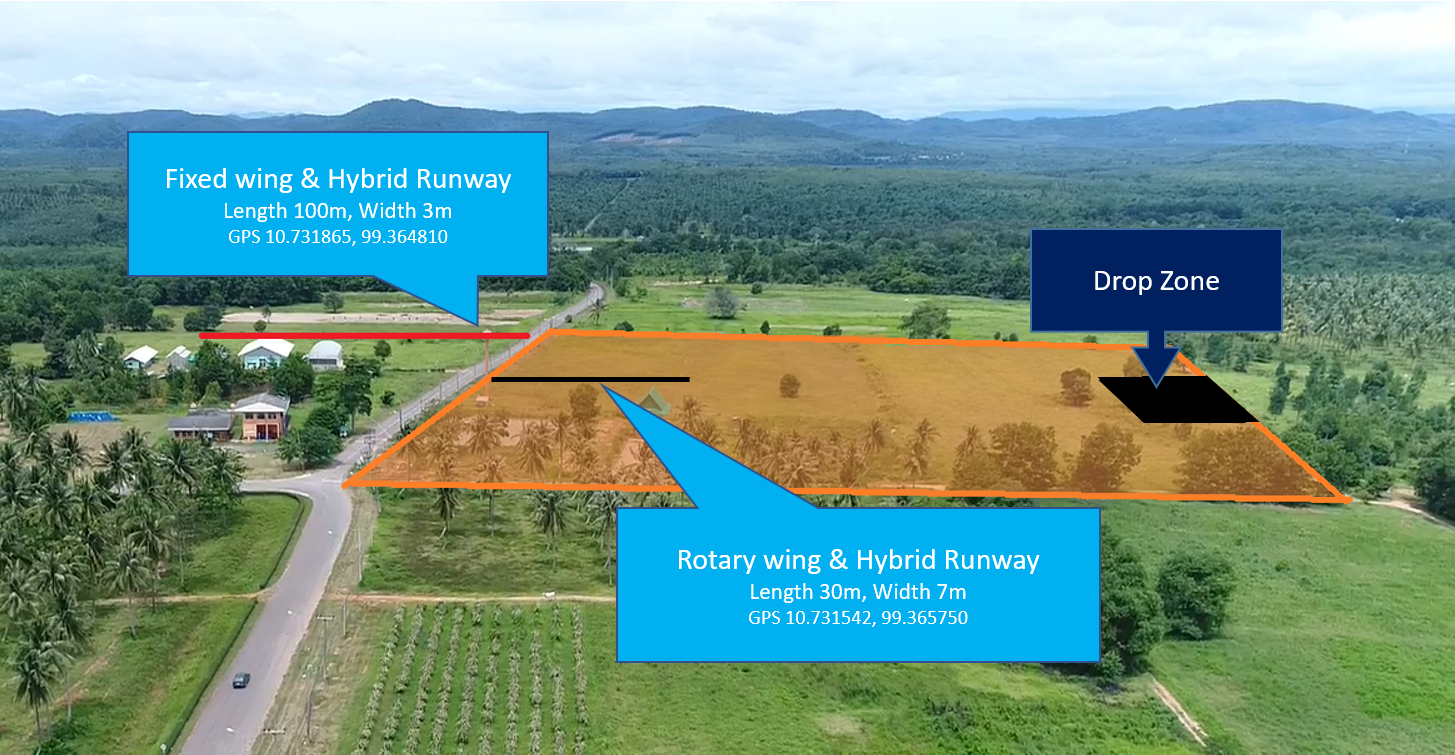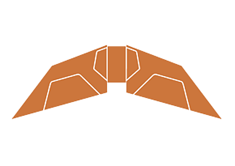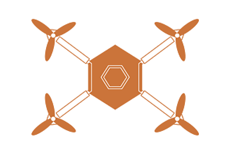Mission Overview
To design, build and demonstrate a UAS to complete the search and rescue tasks which are simulated on the humanitarian aid scenario.
Scenario
During an airborne training, a trainee jumped off an airplane and was assigned to land on a designated landing zone located in an open field. However, right after the deployment, a sudden gust of wind blew the trainee off-course into the nearby valley area where his exact position on the ground could not be identified. Upon landing, the trainee is said to have suffered a laceration on his body part and a sprained ankle from the impact that rendered him immobile. An on-foot Search-and-Rescue (SAR) attempt was unsuccessful, hence, the Training Centre scrambled a UAV for SAR and to deliver a survival kit with rations and first aid (0.5-1.0kg of payload) to the trainee before resuming the helicopter evacuation.

The distance will be closed to beyond visual line of sight (BVLOS). The mission will be dependent on either fixed-wing or rotary-wing. The SAR team (the participants), however, can cross over both tracks, or propose new track according to the scenario provided.
Track 1: Fixed Wing

In this situation, the fixed wing UAV have to conduct an initial scout to identify the location of the trainee and deliver the survival kit.
The fixed wing UAV needs to identify the exact location (GPS coordinate) of the trainee and deliver the survival kit while the SAR team prepares the essential equipment and makes their way in to the location from the Training Centre.
The approximated range is about 1,000 m. There is a need to loiter at location, deliver the payload and constant viewing of the target area for minimum of 10 secs and maximum of 90 secs. This is to get the idea of the vicinity, so that the rescue team can plan the access route.
This track has to be completed within 15 mins.
Track 2: Rotary Wing

In this situation, the rotary wing UAV will be scrambled at the intended landing zone which is closer to the trainee (closer range): locate the trainee and deliver the survival kit.
The rotary wing UAV have to also deliver the survival kit AND collect images of the injuries sustained, i.e. identifying 1.The location of the laceration on his body and 2.The severity (the length of the laceration).
This is for the medic will understand and able to prepare for the treatment, once the trainee is brought back to the base.
The range is about less than 1000 m. To deliver the payload AND collect image, it is required of the platform to hover at the location, auto- landing and/or auto-take off whenever necessary.
This track has to be completed within 15 mins.
Track 3: Hybrid Wing

In this situation, the rotary wing UAV will be scrambled at the intended landing zone which is closer to the trainee (closer range): locate the trainee and deliver the survival kit.
The rotary wing UAV have to also deliver the survival kit AND collect images of the injuries sustained, i.e. identifying 1.The location of the laceration on his body and 2.The severity (the length of the laceration).
This is for the medic will understand and able to prepare for the treatment, once the trainee is brought back to the base.
The range is about less than 1000 m. To deliver the payload AND collect image, it is required of the platform to hover at the location, auto- landing and/or auto-take off whenever necessary.
This track has to be completed within 15 mins.
Call To Action
For the VTOL UAVs, the participants can select either to enter track 1, track 2 or track 3.
Target Locating
The organizer will have to place the mock-up trainee/mannequin (rescue target) from the base to the target area. After locating the target area, the UAV drops the survival kit to the target and returns to launch area.
Points will be awarded with respect to: 1) The accuracy of the location identified and the accuracy of the payload delivered to the target point. The organizer is to provide a Points awarded-to-Accuracy table, and 2) The clarity of the image of the injured, on the location and the length the laceration on his body.
Competition Details
1.First Round Competition
Only the 10 teams with greatest scores will be qualified to challenge in the final round. The selection will be done on January 13th-14th according to the schedule. Each team will have 25 minutes timeslot e.g., test flight and complete the mission. However, the team must notify technical committee when ready to start the mission and the clock will be started for 15 minutes. Scoring will be exactly the same as the final round challenge. Order of flight will be randomly selected and announced during the technical brief session on January 13th, 2020.
2.Final round Competition
The final round competition will be held on the January 14th, 2020 according to the provided schedule. Each of the qualified team will have 15 minute to complete the mission. The score of the qualify round will not be used for the final round. In the case of an even score, the UAV with the least ratio of the UAV/payload weight (maximum payload weight = 1kg) will be considered to be an advantage.
3.Practicing Period
Team may practice on the airfield on January 13th, 2020 at your own responsibility. No scoring will be conducted during that period. It is prohibited to practice on the challenge day.
4.Score System
Track 1: Fixed Wing
The mission performance will be assessed as shown in Table 1 : Mission Performance (total of 100 points)| Scoring Components | Max Points |
|---|---|
| Accuracy of the delivery of the survival kit | Points = (50 – D) + 20W, where D is distance in m away from the mannequin and W is the weight of the payload in kg (Minimum weight 0.5 kg, Maximum weight: 1 kg) (Maximum points: 70, Minimum points: 0) |
| Loiter time | Point = 20T, where T is the time in minutes. (Maximum time: 1.5 minutes) (Maximum points: 30, Minimum points: 0) |
| Time penalty | -2 points for each minute over 15 minutes |
Track 2: Rotary Wing
The mission performance will be assessed as shown in Table 2: Mission Performance (total of 100 points)| Scoring Components | Max Points |
|---|---|
| Accuracy of the delivery of the survival kit | Points = 2.5 x (20 – D) + 20W, where D is distance in m away from the mannequin and W is the weight of the payload in kg (Minimum weight 0.5 kg, Maximum weight: 1 kg) (Maximum points: 70, Minimum points: 0) |
| Clarity of image captured | Participants are required to mark down the injuries sustained on the template given by the organiser. Refer to Annex A. (Maximum points: 30, Minimum points: 0) |
| Time penalty | -2 points for each minute over 15 minutes |
Track 3: Hybrid Wing
The mission performance will be assessed as shown in Table 2: Mission Performance (total of 100 points)| Scoring Components | Max Points |
|---|---|
| Accuracy of the delivery of the survival kit | Points = 2.5 x (20 – D) + 20W, where D is distance in m away from the mannequin and W is the weight of the payload in kg (Minimum weight 0.5 kg, Maximum weight: 1 kg) (Maximum points: 70, Minimum points: 0) |
| Clarity of image captured | Participants are required to mark down the injuries sustained on the template given by the organiser. Refer to Annex A. (Maximum points: 30, Minimum points: 0) |
| Time penalty | -2 points for each minute over 15 minutes |
5.Extra Point
Team may score and extra point provided team can- Perform Auto Takeoff 10 points
- SPerform Autonomously fly and complete the mission 30 points
- Perform Auto Landing 10 points
6.Judges
Professors from Thailand and abroad institutions who are well-known experts in their specialized field are invited to be judge/referees of the challenge. Judge’s decision are final. Judge’s decision are strictly confidential. The organizers reserve the right to amend the rules and regulations.
7.Retry
In an unusual circumstance, the team may retry by landing the UAV and takeoff again. There is no limit on number of retries however the time allowed to complete the mission will not be reset.
8.Setup Time
There will be 5 minutes for setting up and preparing your flight. The counting time will start after the setting up time has elapsed or a team request to start.
9.Payload
In this challenge a payloads weight between 500 g – 1 kg, which simulate the survival kits, are required to be delivered to the target. The target points will be identified to the teams during technical brief session. The payload must be inspected and weight by Technical staff prior starting qualify or the final round. As the payload delivery mission must be completely aerial, the payload must not be equipped with any ground-transportation mechanisms such as wheels or automated arms.
10.Map and Area Information
Teams may obtain more details of the map via this link
11.Tentative schedule
Teams may obtain more details of the map via this link
THE PRESENTATIONThere will be presentation and static display of models and/or seminar by the contestants to showcase their technology, so that, all the participants will learn from each other and foster knowledge exchange. Teams are invited to give 5-10 minutes talk or presentation which will be held during the Welcome Dinner on January 13th, 2020.
ANNEX A
Participants are required to mark down the injuries sustained (the location and the length of the laceration on the body) and points will be awarded accordingly based on the accuracy.

RESTRICTIONS
1.The UAV must not fly greater than 45 m AGL (above ground level) and should not fly lower than 20 m AGL on any part of the mission , expect for takeoff and landing. 2.Strictly never enter the No-fly-zone 3.The team standing by at the takeoff site is prohibited to turn on any remote control/ transmitter 4.Teams must demonstrate an GEOfencing based on the provided data 5.The UAV must be able to take off or land within the designated area. 6.Team must demonstrate the safety protocol at least in the case of losing GPS signal, losing remote control signal, Low battery, Unexpected behavior. 7. Commercially available (ready-made) UAVs are not allowed. 8.Teams must comply with all safety rules set by the organizer. The rules are put together in the interest of everyone safety and security. The organizers reserve the right to disqualify a team for not complying with key safety rules.